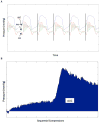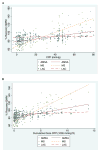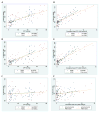Correlation between coronary perfusion pressure and quantitative ECG waveform measures during resuscitation of prolonged ventricular fibrillation
- PMID: 22562057
- PMCID: PMC3443288
- DOI: 10.1016/j.resuscitation.2012.04.013
Correlation between coronary perfusion pressure and quantitative ECG waveform measures during resuscitation of prolonged ventricular fibrillation
Abstract
Introduction: The ventricular fibrillation (VF) waveform is dynamic and predicts defibrillation success. Quantitative waveform measures (QWMs) quantify these changes. Coronary perfusion pressure (CPP), a surrogate for myocardial perfusion, also predicts defibrillation success. The relationship between QWM and CPP has been preliminarily explored. We sought to further delineate this relationship in our porcine model and to determine if it is different between animals with/without ROSC (return of spontaneous circulation).
Hypothesis: A relationship exists between QWM and CPP that is different between animals with/without ROSC.
Methods: Utilizing a prior experiment in our porcine model of prolonged out-of-hospital VF cardiac arrest, we calculated mean CPP, cumulative dose CPP, and percent recovery of three QWM during resuscitation before the first defibrillation: amplitude spectrum area (AMSA), median slope (MS), and logarithm of the absolute correlations (LAC). A random effects linear regression model with an interaction term CPP ROSC investigated the association between CPP and percent recovery QWM and how this relationship changes with/without ROSC.
Results: For 12 animals, CPP and QWM measures (except LAC) improved during resuscitation. A linear relationship existed between CPP and percent recovery AMSA (coefficient 0.27; 95%CI 0.23, 0.31; p<0.001) and percent recovery MS (coefficient 0.80; 95%CI 0.70, 0.90; p<0.001). A linear relationship existed between cumulative dose CPP and percent recovery AMSA (coefficient 2.29; 95%CI 2.0, 2.56; p<0.001) and percent recovery MS (coefficient 6.68; 95%CI 6.09, 7.26; p<0.001). Animals with ROSC had a significantly "steeper" dose-response relationship.
Conclusions: There is a linear relationship between QWM and CPP during chest compressions in our porcine cardiac arrest model that is different between animals with/without ROSC.
Copyright © 2012 Elsevier Ireland Ltd. All rights reserved.
Conflict of interest statement
Conflict of Interest Statement
Disclosures: Dr. Menegazzi is a co-inventor of a patented quantitative method of ECG analysis (the scaling exponent), which has been licensed to Medtronic Physio-Control, from which he receives royalties. To avoid potential conflict of interest, the scaling exponent was not utilized in data analysis for this manuscript. Neither of the other authors have anything to disclose.
Figures




Similar articles
-
Beta-blockade causes a reduction in the frequency spectrum of VF but improves resuscitation outcome: A potential limitation of quantitative waveform measures.Resuscitation. 2012 Apr;83(4):511-6. doi: 10.1016/j.resuscitation.2011.09.026. Epub 2011 Oct 10. Resuscitation. 2012. PMID: 21996018
-
Coronary perfusion pressure and return of spontaneous circulation after prolonged cardiac arrest.Prehosp Emerg Care. 2010 Jan-Mar;14(1):78-84. doi: 10.3109/10903120903349796. Prehosp Emerg Care. 2010. PMID: 19947871 Free PMC article.
-
Utility of the ventricular fibrillation waveform to predict a return of spontaneous circulation and distinguish acute from post myocardial infarction or normal Swine in ventricular fibrillation cardiac arrest.Circ Arrhythm Electrophysiol. 2011 Jun;4(3):337-43. doi: 10.1161/CIRCEP.110.960419. Epub 2011 Apr 14. Circ Arrhythm Electrophysiol. 2011. PMID: 21493961
-
The physiology and potential of spectral amplitude area (AMSA) as a guide for resuscitation.Resuscitation. 2025 May;210:110557. doi: 10.1016/j.resuscitation.2025.110557. Epub 2025 Feb 21. Resuscitation. 2025. PMID: 39988280 Review.
-
[Analysis of ventricular fibrillation signals for the evaluation of defibrillation success in the treatment of ventricular fibrillation].Anasthesiol Intensivmed Notfallmed Schmerzther. 2003 Dec;38(12):787-94. doi: 10.1055/s-2003-45401. Anasthesiol Intensivmed Notfallmed Schmerzther. 2003. PMID: 14666442 Review. German.
Cited by
-
Machine learning model to predict evolution of pulseless electrical activity during in-hospital cardiac arrest.Resusc Plus. 2024 Mar 8;17:100598. doi: 10.1016/j.resplu.2024.100598. eCollection 2024 Mar. Resusc Plus. 2024. PMID: 38497047 Free PMC article.
-
Combining Amplitude Spectrum Area with Previous Shock Information Using Neural Networks Improves Prediction Performance of Defibrillation Outcome for Subsequent Shocks in Out-Of-Hospital Cardiac Arrest Patients.PLoS One. 2016 Feb 10;11(2):e0149115. doi: 10.1371/journal.pone.0149115. eCollection 2016. PLoS One. 2016. PMID: 26863222 Free PMC article.
-
Extracorporeal life support during cardiac arrest resuscitation in a porcine model of ventricular fibrillation.J Extra Corpor Technol. 2013 Mar;45(1):33-9. J Extra Corpor Technol. 2013. PMID: 23691782 Free PMC article.
-
Predict Defibrillation Outcome Using Stepping Increment of Poincare Plot for Out-of-Hospital Ventricular Fibrillation Cardiac Arrest.Biomed Res Int. 2015;2015:493472. doi: 10.1155/2015/493472. Epub 2015 Sep 2. Biomed Res Int. 2015. PMID: 26413527 Free PMC article.
-
Real-time amplitude spectrum area estimation during chest compression from the ECG waveform using a 1D convolutional neural network.Front Physiol. 2023 Apr 20;14:1113524. doi: 10.3389/fphys.2023.1113524. eCollection 2023. Front Physiol. 2023. PMID: 37153217 Free PMC article.
References
-
- Weisfeldt ML, Becker LB. Resuscitation after cardiac arrest: a 3-phase time-sensitive model. JAMA. 2002;288:3035–8. - PubMed
-
- Cobb LA, Fahrenbruch CE, Walsh TR, et al. Influence of cardiopulmonary resuscitation prior to defibrillation in patients with out-of-hospital ventricular fibrillation. JAMA. 1999;281:1182–8. - PubMed
-
- Wik L, Hansen TB, Fylling F, et al. Delaying defibrillation to give basic cardiopulmonary resuscitation to patients with out-of-hospital ventricular fibrillation: a randomized trial. JAMA. 2003;289:1389–95. - PubMed
-
- Berg RA, Hilwig RW, Ewy GA, Kern KB. Precoutnershock cardiopulmonary resuscitation improves initial response to defibrillation from prolonged ventricular fibrillation: a randomized, controlled swine study. Critical Care Medicine. 2004;32:1352–7. - PubMed
-
- Neumar RW, Brown CG, Van Ligten P, Hoekstra J, Altschuld RA, Baker P. Estimation of myocardial ischemic injury during ventricular fibrillation with total circulatory arrest using high-energy phosphates and lactate as metabolic markers. Ann Emerg Med. 1991;20:222–9. - PubMed
Publication types
MeSH terms
Grants and funding
LinkOut - more resources
Full Text Sources
Medical

